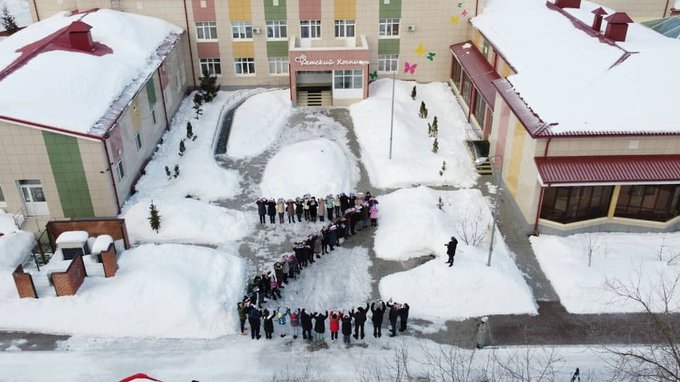
The “Z” sign, used to mark the vehicles of the Russian invasion force, has now become synonymous with the war as a whole. Lithuanian MPs say it is on par with Communist and Nazi signs, which are already banned in the country. Displaying symbols such as the Nazi swastika can lead to fines. If the new proposal moves ahead, displaying the symbol “Z” in public, as well as the Georgian ribbon associated with the Russian military, will be the same as flashing the Communist hammer and sickle or the Nazi SS or swastika signs. The fines could range from 300 to 500 euros.
Yes, the letter Z is becoming a symbol of Russia’s war in Ukraine. But what does it mean? Messages featuring the letter “Z” have spread widely across social media since Russia’s invasion of Ukraine. Billboards have recently popped up in Russian cities featuring the letter. Stickers have appeared on cars and commercial vehicles. Russia’s state-owned RT is selling T-shirts on its website in apparent support of the ongoing conflict.
Prior to Russia’s invasion of Ukraine, the letter “Z” was seen painted on tanks as well as other military vehicles massing near the border. With both countries using similar tanks and trucks, it was originally thought this was meant to distinguish different units to prevent friendly fire and assist with mobilization.
Some speculate that the “Z” could stand for “zapad,” which means west in Russian. The letter does not appear in the Cyrillic alphabet used by both Russia and Ukraine. The Instagram account of the Russian Ministry of Defense has featured both “Z” and “‘V” symbols with messages of “to victory” and “we finish wars.” Another message states “we are responsible for the world/peace.” The black-and-orange ribbons that make up the “Z” are St. George’s ribbons, which are symbols of remembrance of Russians who died during World War II similar to the UK and Canada’s usage of the poppy for the fallen during World War I. Russia has repeatedly framed its invasion of Ukraine as defending its people from neo-Nazis although Ukraine President Volodymyr Zelenskyy is Jewish. The Saint George ribbons are ubiquitous in Russia, particularly in the weeks ahead of its annual Victory Day celebration on May 9. They have served as a powerful and effective unifying symbol under Putin, tying together support for the state and the country’s historic contribution to defeating fascist encroachment.
Russian gymnast Ivan Kuliak is facing disciplinary action by the International Gymnastics Federation (FIG) after taping the symbol to his uniform in place of the banned Russian flag at a gymnastics World Cup event in Qatar. Kuliak was standing next to Ukrainian Illia Kovtun. The FIG has since banned both Russian and Belarusian athletes from competing in its events.
A widely spread image shows patients and staff of a children’s hospice forming the symbol in a snow-covered courtyard in Kazan, the capital and largest city of Tatarstan, a semi-autonomous republic in Russia.
A video with more than 1 million views has spread online showing people waving the Russian flag behind a group wearing hoodies bearing the symbol. The symbol has also reportedly been painted on the doors of prominent Russians such as film critic Anton Dolin as well as Pussy Riot member Rita Flores in an apparent attempt at intimidation.
The letter “Z” of the Latin alphabet — which does not exist in the Cyrillic Russian alphabet — has been deployed beyond the military, pointing to what some experts say is a state-led effort to ramp up support for the war. Several videos shared on social media in recent weeks show what appeared to be flash mobs of young demonstrators dancing amid a sea of Russian flags and wearing black T-shirts with the Z.
The letter has also been painted on large apartment blocks and posted on advertising signs in major cities, on subway stations, and behind Putin at a St. Petersburg rally to mark the eighth anniversary of Russia’s annexation of Crimea.
Public figures and government officials have also appropriated the symbol. Maria Butina, a member of the Russian parliament who was convicted in the United States as an unregistered foreign agent for Russia, posted a video of herself drawing a white “Z” on the lapel of her jacket.
Maria Snegovaya, a scholar of Russia’s domestic and foreign policy, told The Washington Post the orange-and-black “Z” creates a link between the ongoing invasion and celebrations of the victory in World War II, which she said is understood as “the historic Russian fight against the West.” It also bolsters the idea of Russia being “historically the winner,” she said.
“It’s important for Putin to create this connection and build this quasi-ideology, which is not really well developed but it is definitely shaping — and whether it is successful remains to be seen,” she told The Post.
As the Z appears to be everywhere in Russia, experts say it has now become a potent symbol, intended to show a united Russia in wartime. In this sense, the Z has become a symbol of a new Russian ideology and national identity. Experts such as Kamil Galeev, a former Wilson Center fellow who researched Russian identity politics from Moscow, say its sudden use among many Russians follows a state-organized propaganda campaign to rally support, or at least create the impression to the outside world that Russian people stand behind the invasion.
“It is clearly propagated by and organized by the state with the purpose of creating a sense of broad public support for the invasion,” said Henry E. Hale, a professor of political science and international affairs at George Washington University. But such efforts can also be used to influence and coerce others into embracing the regime’s policies — or at least into pretending to, said Hale, who specializes in Russian and Ukrainian politics. “If many people see many others displaying symbols, it puts pressure on other people to show the same kind of support to stay in the good graces of the regime, not run into trouble with neighbors and to adopt the socially desirable position.”
And those who do not show such support may be punished. According to independent media website Meduza, a man in southern Russia was fined 30,000 rubles — about $2,800 U.S. — for spitting on the letter Z.





























